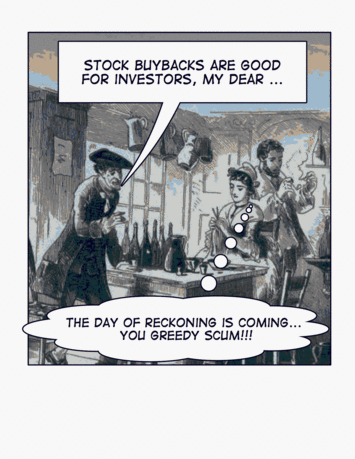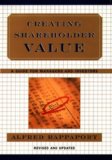The Federal Reserve Board does not make a practice of announcing when the stock market is in the midst of a speculative bubble. It officially notes deviant market behavior only well after the event, when it is too late for investors. Most shareholders will not realize they are now in hazardous times — this will have to wait until the bubble pops and dreams fade.
Most investors will pass through these days of madness, hardly appreciating the spectacle that surrounds them.
However, I will step into the breach and make an unsolicited public service announcement:
The Great Buyback Bubble is now official! Look around you and behold!
The Federal Reserve flow of funds accounts have signaled that there is a massive disequilibrium in the US equity market for over a year, and my ‘Googlemeter‘ brings daily emails documenting increasing symptoms of irrationality in the feverish buyback market.
Major companies now borrow heavily to transfer corporate cash to speculators and to their own executives through the magic of ‘buybacks’. Rating agencies are downgrading credit scores of major companies that prefer to squander shareholders’ funds in pursuit of a transitory up-blip in equity prices, at the expensive of the well-being of not only their permanent shareholders, but of the economy and the nation as well.
And the amounts involved in buybacks are truly impressive, now exceeding one trillion dollars in less than two years.
The Federal Reserve, the Securities and Exchange Commission, and Congress are confused and unsure of what it all means.
Except that one thing is certain: when the buybacks stop, the market will crash. Buybacks are the only thing keeping stock prices up.
Signs of the times
Two items that came in recently really rang a bell, indicating that we are indeed living through perilous years of speculative froth:
What is so interesting about these articles? Why do they confirm that the Buyback Bubble should now be considered official?
Paul Krugman Blames Buybacks on Bush
Professor Krugman, like many others, has noticed the buyback boom, but, his article suggests that he thinks that this behavior is somehow new — undoubtedly the product of the misguided Bush administration.
He writes:
In “the Bush years high profits haven’t led to high investment, and rising productivity hasn’t led to rising wages. … Why aren’t corporations investing, and what does the lack of business investment mean for the economy? … many companies are using profits to buy back their own stock. And cynics suggest that the purpose of these buybacks is to produce a temporary rise in stock prices that increases the value of executives’ stock options, even if it’s against the long-term interests of investors… Researchers at the Federal Reserve have found evidence that company decisions about stock buybacks are strongly influenced by “agency conflicts,” a genteel term for self-dealing by corporate insiders…. we now have an economy with incredibly high profits and surprisingly low investment. This raises some immediate, short-run concerns… optimistic projections for the economy depend on vigorous growth in business investment. And that doesn’t seem to be happening. … High investment in equipment and software was one major reason for the productivity takeoff that began in the Clinton era, and continued in the early years of this decade. And low investment may be one reason productivity growth has slowed….”
An economist who believes in the “Rational Man” might see a “disconnect” between how corporate managers behave and how they are presumed to behave, but this is merely an indication of the Irrationality Axiom used in capital flow analysis — in fact, a disconnect between the persistent fantasies of theoretical economists and the real world.
Professor Krugman is correct in suggesting that stock buybacks on the current scale are not proper and are detrimental to the economic future of the country.
However, the professor goes astray by suggesting that this behavior is somehow new — a result of President Bush’s wrong-headed policies and a detour from the wise economic path followed in the Clinton years.
The fact is that corporate executives have been playing the buyback game now for over fifteen years! Buybacks were the major factor in the so-called Dot.com Bubble of the 1990s, the Clinton years, which ended with the Crash of 2000, wiping out more investor value than any time since the Great Depression.
Emulating Rosy O’Donnell
But what is really exciting about Professor Krugman’s article is how he emulates Rosy O’Donnell, misinterpreting the facts and politicizing a long-term behavioral pattern that, in fact, has been bipartisan.
The tricky thing about economic bubbles is knowing how to deflate them without decimating the savings of a major segment of the population. However, the Democratic Party is entirely dependent upon losing the War in Iraq in order to put Hillary Clinton in the White House, and a stock market crash just before the election that could be blamed on Bush would be a nice extra bonus — a cherry on the cake, so to speak.
Now, no one knows when the Great Buyback Bubble will implode, but the Democratic Party would be far better off if this happens while George Bush is still in office, rather than during the first term of President Hillary.
So, when I read an article by a left-wing economist, a perennial Bush-basher, with the bully pulpit of the New York Times, attacking buybacks with political motives, I would say its time to be out of equities.
Remember, Barney Frank now oversees securities markets in the US House of Representatives.
|
|
|
|
Getting out before all birds start pointing south ...
|
|
|
|
|
Crashing the Market for Political Gain
Here’s how easy it would be to crash the market:
Pass a law removing double taxation on dividends (President Bush would certainly sign that!);
Pass another law increasing the capital gains tax on executive stock options, in proportion to the percentage of profits paid out in buybacks, up to 90% (An appeal to populist sentiment against greedy corporate executives).
The SEC has been asleep as regards the perils of buybacks and a small poke in the ribs from Congress (now controlled by the Democrats) could produce a rule that would stop buybacks in a heartbeat, which in combination with skewing tax incentives would crash the market.
And since the great masses don’t know what is going on anyway, the ensuing economic disaster, like Hurricane Katrina and Global Warming, could be blamed on George Bush.
If the Democratic Party is willing to lose a War to gain a presidency and a few seats in the Senate, why not take away the savings of long-term investors while you’re at it — after all, most long-term investors are probably Republicans — and big Democratic speculators, like Soros, will be able to profit by selling short.
Securities Analysts Gone Wild!
The second sociological artifact of the Buyback Bubble is an article by Paul Hickey and Justin Walters in Seeking Alpha, that may have started Ben Graham spinning in his grave. Analyzing the results of Amazon.com, the Internet retailer, they wrote:
“There was one aspect of the [Amazon financial] report that received little attention. While the company’s earnings yield based on 2007 EPS forecasts is a meager 1.6%, one area where the company has had an amazing return on investment is stock repurchases. Since August 2006, the company has spent $500 million buying back 14 million shares of its stock (approximately 3.4% of outstanding shares). … Those 14 million shares which the company spent $500 million buying back are now worth $868 million for a profit of $368 million in less than a year (73%)! To put that number in perspective, the unrealized profit on the stock buybacks is nearly twice as much as the company made all last year.”
So, lets get this straight.
Amazon.com spent $500 million dollars in canceling its shares, taking them off the market. It now has $500 million dollars less than it had before the stock buyback. There are no assets received as a ‘quid pro quo’ for this disbursement of $500 million dollars. They didn’t ‘buy’ anything with this money. The remaining shareholders have a larger percentage of a company with $500 million less in cash.
Even though the price of Amazon.com shares went up after the buybacks, the company did not benefit from this at all. It had no ‘assets’ that increased in value, producing an ‘unrealized profit’ of $368 million. (This truly was an ‘unrealized profit’ in the absolute sense.)
Now, I really don’t want to pick on Hickey and Walters. If fact, their way of analyzing the market seems to be quite common at this stage of the Buyback Bubble and, for all I know, they may have been taught this type of analysis in business school.
I wrote an essay on “The Great Misleading” that spoke of buybacks as “frauds so well conducted that it would be stupidity not to be deceived by them”, dealing with the clever arguments of those promoting buybacks during the 1990s. Today’s feverish articles extolling buybacks are not as sophisticated in their reasoning as those of a decade ago.
This is just another sign of the advanced stage of the buyback sickness that has caught up so many.






